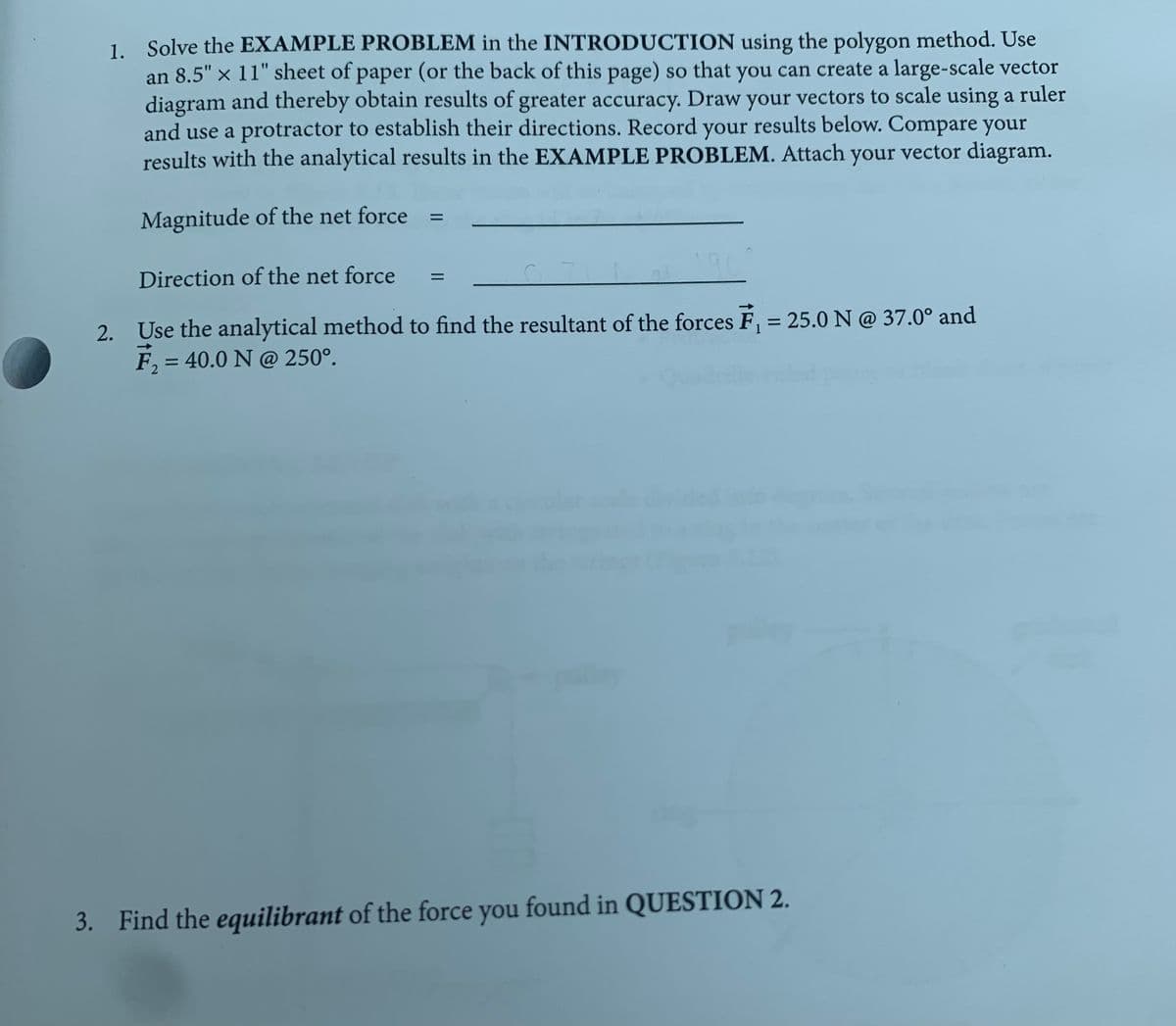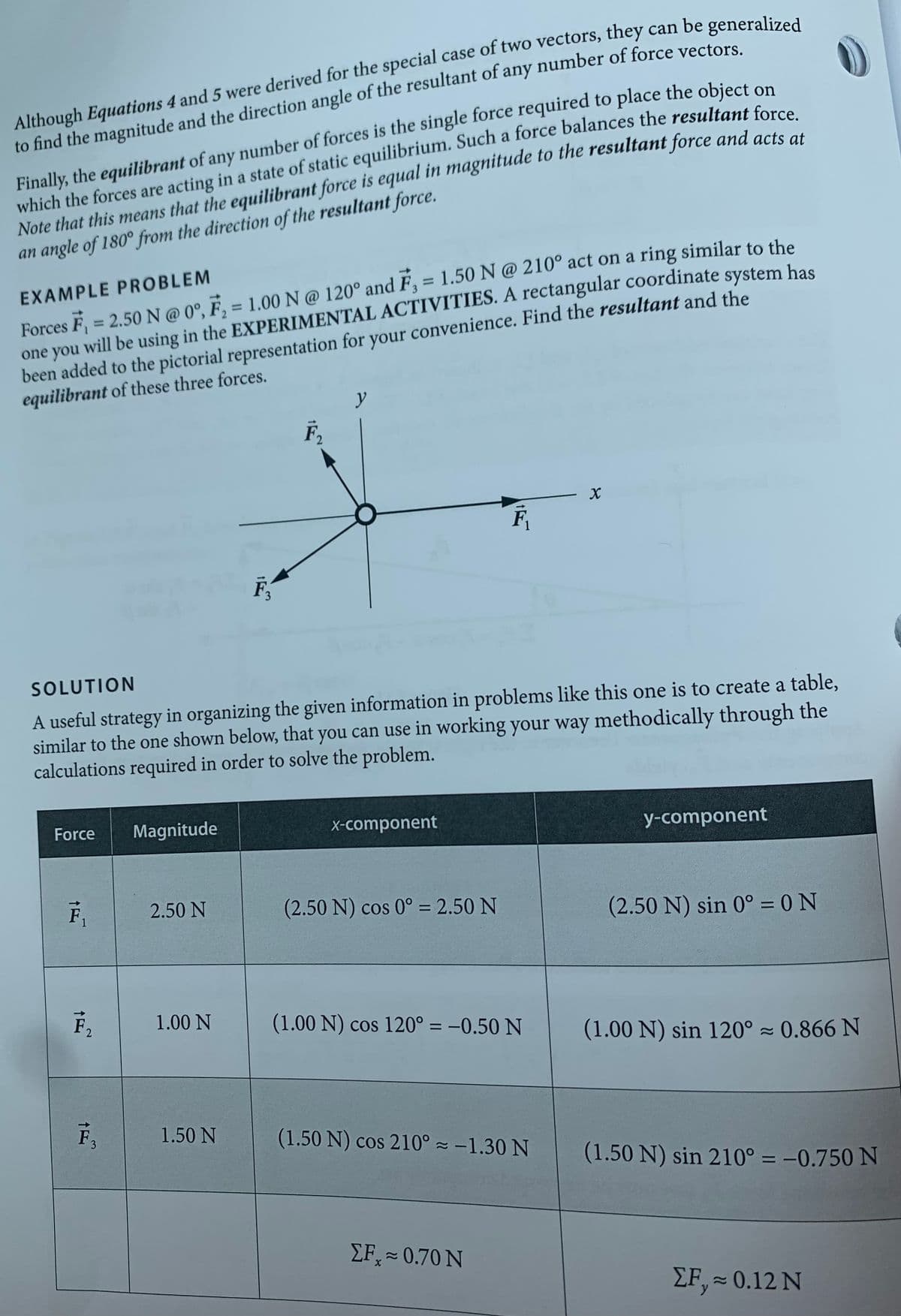answers that would be very helpful
Trigonometry (MindTap Course List)
8th Edition
ISBN:9781305652224
Author:Charles P. McKeague, Mark D. Turner
Publisher:Charles P. McKeague, Mark D. Turner
Chapter7: Triangles
Section: Chapter Questions
Problem 1RP: We mentioned in Section 7.5 that our algebraic treatment of vectors could be attributed, in part, to...
Related questions
Question
100%
If you can label the answers that would be very helpful

Transcribed Image Text:1. Solve the EXAMPLE PROBLEM in the INTRODUCTION using the polygon method. Use
an 8.5" x 11" sheet of paper (or the back of this page) so that you can create a large-scale vector
diagram and thereby obtain results of greater accuracy. Draw your vectors to scale using a ruler
and use a protractor to establish their directions. Record your results below. Compare your
results with the analytical results in the EXAMPLE PROBLEM. Attach your vector diagram.
Magnitude of the net force
%3D
Direction of the net force
%3D
2. Use the analytical method to find the resultant of the forces F, = 25.0 N @ 37.0° and
F, = 40.0 N @ 250°.
%3D
%3D
3. Find the equilibrant of the force you found in QUESTION 2.

Transcribed Image Text:Although Equations 4 and 5 were derived for the special case of two vectors, they can be generalis
to find the magnitude and the direction angle of the resultant of any number of force vectore
Finally, the equilibrant of any number of forces is the single force required to place the obiect
which the forces are acting in a state of static equilibrium. Such a force balances the resultant fon
Note that this means that the equilibrant force is equal in magnitude to the resultant force and acte o
an angle of 180° from the direction of the resultant force.
EXAMPLE PROBLEM
Forces F = 2.50 N@ 0°, F, =
one you will be using in the EXPERIMENTAL ACTIVITIES. A rectangular coordinate system hae
been added to the pictorial representation for your convenience. Find the resultant and the
equilibrant of these three forces.
%3D
1.00 N @ 120° and F, = 1.50N@ 210° act on a ring similar to the
%3D
%3D
y
F,
SOLUTION
A useful strategy in organizing the given information in problems like this one is to create a table,
similar to the one shown below, that you can use in working your way methodically through the
calculations required in order to solve the problem.
Force
Magnitude
X-component
y-component
2.50 N
(2.50 N) cos 0° = 2.50 N
%3D
(2.50 N) sin 0° = 0 N
%3D
F2
1.00 N
(1.00 N) cos 120° = -0.50 N
%3D
(1.00 N) sin 120° ~ 0.866 N
F,
1.50 N
(1.50 N) cos 210° - -1.30 N
(1.50 N) sin 210° = -0.750 N
%3D
ΣF,0.70 Ν
ΣF,-0.12Ν
Expert Solution
This question has been solved!
Explore an expertly crafted, step-by-step solution for a thorough understanding of key concepts.
This is a popular solution!
Trending now
This is a popular solution!
Step by step
Solved in 5 steps with 2 images

Recommended textbooks for you

Trigonometry (MindTap Course List)
Trigonometry
ISBN:
9781305652224
Author:
Charles P. McKeague, Mark D. Turner
Publisher:
Cengage Learning

Algebra & Trigonometry with Analytic Geometry
Algebra
ISBN:
9781133382119
Author:
Swokowski
Publisher:
Cengage

Linear Algebra: A Modern Introduction
Algebra
ISBN:
9781285463247
Author:
David Poole
Publisher:
Cengage Learning

Trigonometry (MindTap Course List)
Trigonometry
ISBN:
9781305652224
Author:
Charles P. McKeague, Mark D. Turner
Publisher:
Cengage Learning

Algebra & Trigonometry with Analytic Geometry
Algebra
ISBN:
9781133382119
Author:
Swokowski
Publisher:
Cengage

Linear Algebra: A Modern Introduction
Algebra
ISBN:
9781285463247
Author:
David Poole
Publisher:
Cengage Learning